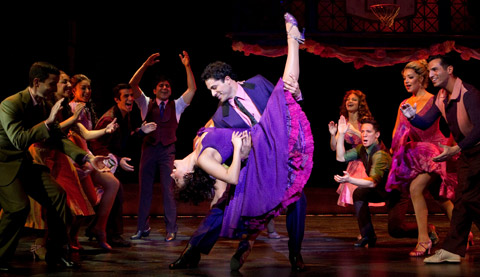
TOTAL THEATER At its best, this show captures original director Jerome Robbins’s seamless, powerful interface of styles — dancing and action, singing and speech. |
Like its ancestor, Shakespeare's Romeo and Juliet, West Side Story has sustained revivals, reworkings, and well-intentioned tweaks — some of them very successful. Since its Broadway debut in 1957 under the dynamite team of Jerome Robbins, Leonard Bernstein, Stephen Sondheim, and Arthur Laurents, the show has been made into a Hollywood movie, condensed for the revue Jerome Robbins' Broadway, crafted as a suite of dances for New York City Ballet, and reproduced by countless local theater groups and road companies. The touring production now at the Colonial Theater (through July 9) suits a modern audience without extinguishing the show's greatest assets.
Created before the widespread use of archival film and video, the production has been handed down from one trusted lieutenant to the next, each generation altering the imprint a little bit. The current version comes to Boston via the 2009 Broadway model, rethought and directed by Arthur Laurents, and passed on to David Saint, who directed the road company. This genealogy is important, because while the dances and the music became iconic signs of urban tension and longing ("Maria," "Tonight," "Cool"), over time the show as a whole was sliding into the dissociated grooves of memory.
In Boston the production captures Robbins's choreography very well under dance director/reconstructor Joey McKneely, who entered the Robbins history as a dancer in Jerome Robbins' Broadway. Who doesn't recognize those thigh-high finger snaps and crouching, jump-rope leaps that rally the Jets? Or the Sharks' strutting mambo in the dance at the gym? Or the realistic, surging violence of the gang fights — every inch of it choreographed?
The seamless interface of styles — dancing and action, singing and speech — is the key to Robbins's great power in the theater. His ballets too wove steps together with realistic behavior, as seen this spring in Boston Ballet's production of Afternoon of a Faun. Perhaps it's too much to expect a touring show to muster actors who can sing and dance, but that's what Robbins insisted on. In fact, he spent a few years in the '70s on a workshop project, American Theater Laboratory, to strengthen these crossover skills and develop new theater forms that would exploit them.
West Side Story's Boston cast is unevenly proficient in what the show demands. Some principals talk and move as if they've never been above 57th Street. The members of the dancing ensemble look strenuous, athletic, chronically angry, but they don't convey any distinction between white and Hispanic personas. That chasm, the crux of the plot, is strongest when the dialogue breaks into Spanish. Interpolated by Laurents for the 2009 revival, this linguistic shift has been controversial, but to a native New Yorker it seems perfectly natural. It's what you hear today in the streets of Gotham. In fact, the Spanish-English ping-pong felt more authentic to me than the generic flouncing and can-can kicks of the women's numbers, "I Feel Pretty" and "America."